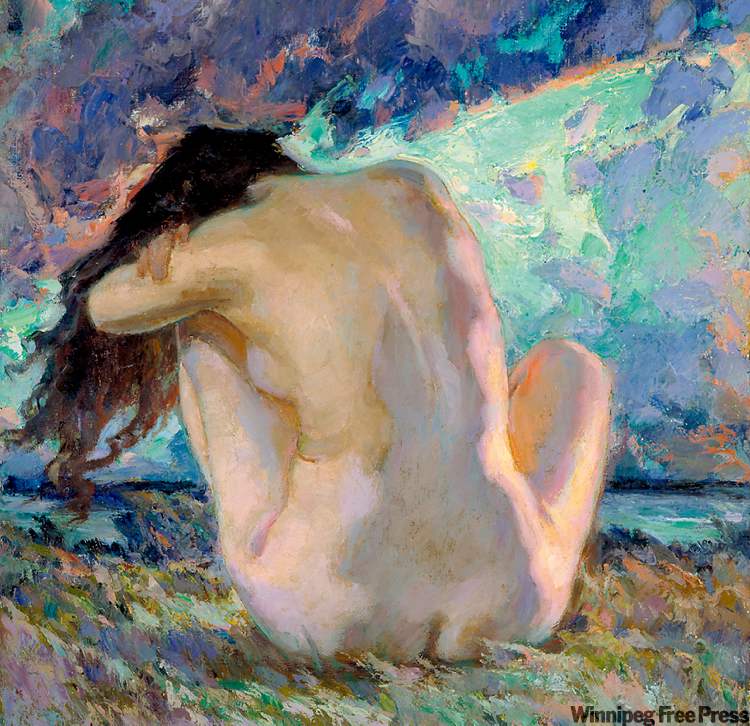Exhibit tracks changing views about nudes
Portrayals of naked body moved from fusty to frank
Advertisement
Read this article for free:
or
Already have an account? Log in here »
To continue reading, please subscribe:
Monthly Digital Subscription
$0 for the first 4 weeks*
- Enjoy unlimited reading on winnipegfreepress.com
- Read the E-Edition, our digital replica newspaper
- Access News Break, our award-winning app
- Play interactive puzzles
*No charge for 4 weeks then price increases to the regular rate of $19.00 plus GST every four weeks. Offer available to new and qualified returning subscribers only. Cancel any time.
Monthly Digital Subscription
$4.75/week*
- Enjoy unlimited reading on winnipegfreepress.com
- Read the E-Edition, our digital replica newspaper
- Access News Break, our award-winning app
- Play interactive puzzles
*Billed as $19 plus GST every four weeks. Cancel any time.
To continue reading, please subscribe:
Add Free Press access to your Brandon Sun subscription for only an additional
$1 for the first 4 weeks*
*Your next subscription payment will increase by $1.00 and you will be charged $16.99 plus GST for four weeks. After four weeks, your payment will increase to $23.99 plus GST every four weeks.
Read unlimited articles for free today:
or
Already have an account? Log in here »
Hey there, time traveller!
This article was published 29/07/2010 (5605 days ago), so information in it may no longer be current.
The nude in Canadian art no longer shocks, but this absorbing show at the Winnipeg Art Gallery still manages some moments of goosepimply awkwardness. Nakedness is an odd fit with our art historical heritage, and maybe that’s a good thing.
A nude woman reclining on a 16th-century Tuscan hillside can easily be taken for granted, but put her in the middle of northern Ontario on an overcast day and suddenly you have to ask some hard questions about the genre. This touring exhibition — organized by the Musée national des beaux-arts du Quebec — is a fascinating window onto our shifting assumptions about culture and nature, artist and creation, women and men, sex and society.
Concentrating on the period between 1920 and 1950, curators Michèle Grandbois and Anna Hudson begin with some fusty but fascinating holdovers from 19th-century academic art. These photographers and painters feel compelled to justify their nudes by outfitting their "nymphs" and "odalisques" with Greco-Roman plaster props or the trappings of some imagined Orient. Paradoxically, for all their respectable pretensions, many of these works come off as high-toned girly pics.

The nude eventually becomes more frank under the influences of European modernism and North American realism. The fraught battle between Canada’s isolated avant-garde artists and a prim public was outlined in Nudes and Prudes, an influential 1931 essay by writer and painter Bertram Brooker. (Brooker’s own nudes, three of which are in this exhibition, display a deliberate and austere anti-eroticism.)
A 1933 painting by Lilias Torrance Newton shows a female nude in the artist’s studio, in a matter-of-fact standing pose that reveals the angular planes of her body. Accepted by the jury of the Canadian Group of Painters, it was censored by the Art Gallery of Toronto, which felt that the model’s green satin-strapped high-heeled shoes made her look merely undressed rather than artistically nude.
While the studio nude was a popular subject, the curators categorize several paintings from the ’30s and ’40s as "Outdoor Nudes." These works combine the landscape genre popularized by the Group of Seven with figurative art. As demonstrated by Edwin Holgate’s Early Autumn (1938), which shows a naked woman gingerly navigating an outcropping of sharp rocks and twisted tree roots, this can be a prickly undertaking in the Canadian wilderness.
Most of the exhibition’s 110 works, which include sculpture, drawings, photographs, prints and paintings, depict the female nude. The male nudes make intriguing exceptions, from the elegant post-Impressionism of John Lyman’s Indolent Youth to several works by Canadian war artists, which combine documentary purpose with poetic subtext. Charles Jefferys paints Polish soldiers in Niagara bathing beneath a row of uniformed officers, making for a poignant contrast between military regularity and the vulnerability of exposed flesh.
One of the show’s most arresting paintings is Prudence Heward’s Dark Girl (1935). Historically, the nude was often situated at a strange juncture of sex and race, where women of colour were viewed as exotic. Heward plays against these conventional expectations — and undercuts any sense of sexual availability — with her tender and specific delineation of a weary African-Canadian woman, her arms clutched around herself in a hunched, protective posture.
Because The Nude in Modern Canadian Art deals with all kinds of charged ideas, the show’s organization, particularly the relationship between background text and art works, could be clearer. Still, as an introduction to our country’s often uneasy, always revealing relationship with art and the nude, this comprehensive show is worth a look.
alison.gillmor@freepress.mb.ca
Art review
The Nude in Modern Canadian Art: 1920-1950
Winnipeg Art Gallery
Until Aug. 22

Studying at the University of Winnipeg and later Toronto’s York University, Alison Gillmor planned to become an art historian. She ended up catching the journalism bug when she started as visual arts reviewer at the Winnipeg Free Press in 1992.
Our newsroom depends on a growing audience of readers to power our journalism. If you are not a paid reader, please consider becoming a subscriber.
Our newsroom depends on its audience of readers to power our journalism. Thank you for your support.

